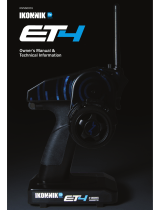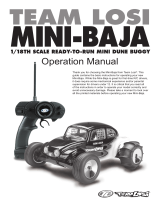
4
•
TRAXXAS
This model is not intended
for use by children under
14 years of age without the
supervision of a responsible
and knowledgeable adult.
All instructions and
precautions outlined in this
manual should be strictly
followed to ensure safe
operation of your model.
SAFETY PRECAUTIONS
Previous experience with
radio controlled models
is recommended. Models
require a higher level of
setup, maintenance, or
support equipment.
Skill Level = Myriad Semi Bold
1 2 3 3+ 4 5
bluehighway font
For Expert Drivers
Choose the Model That is Right For You. For individual Models
No previous experience with radio controlled models is required.
Models require a minimum of setup, maintenance, or support equipment.
Previous experience with radio controlled models is mandatory. These
models are capable of high speeds, requiring experienced driving control.
Models require detailed setup, and/or maintenance procedures with required
support equipment.
Previous experience with radio controlled models is mandatory.
These models are capable of very high speeds and require an even higher
level of skilled driving control. Models require detailed setup, and/or mainte-
nance procedures with required support equipment.
For Expert Drivers Only. This product is capable of extreme speed
and acceleration! It carries our highest skill level rating and is intended
for expert drivers only. Experience with nitro-powered radio controlled
models is required!
Previous experience with radio controlled models is recommended.
Models require a higher level of setup, maintenance, or support equipment.
No previous experience with radio controlled models is required.
Model requires a minimum of setup, maintenance, or support equipment.
Previous experience with radio controlled models is mandatory. This model is
capable of high speeds, requiring experienced driving control. Model requires
detailed setup, and/or maintenance procedures with required support
equipment.
Previous experience with radio controlled models is mandatory. This model is
capable of very high speeds and requires an even higher level of skilled driving
control. Model requires detailed setup, and/or maintenance procedures with
required support equipment.
For Expert Drivers Only. This product is capable of extreme speed
and acceleration! It carries our highest skill level rating and is intended
for expert drivers only. Experience with nitro-powered radio controlled
models is required!
Previous experience with radio controlled models is recommended.
Model requires a higher level of setup, maintenance, or support equipment.
BELOW TEXT HAS BEEN UPDATED on 3-14-07
Kent wants maintenance text to be at the END of the paragraph.-- KB
All of us at Traxxas want you to safely enjoy your new model. Operate your model
sensibly and with care, and it will be exciting, safe, and fun for you and those
around you. Failure to operate your model in a safe and responsible manner may
result in property damage and serious injury. The precautions outlined in this
manual should be strictly followed to help ensure safe operation. You alone must
see that the instructions are followed and the precautions are adhered to.
IMPORTANT POINTS TO REMEMBER
•
Your model is not intended for use on public roads or congested areas where its
operation can conflict with or disrupt pedestrian or vehicular traffic.
•
Never, under any circumstances, operate the model in crowds of people. Your
model is very fast and could cause injury if allowed to collide with anyone.
•
Because your model is controlled by radio, it is subject to radio interference from
many sources that are beyond your control. Since radio interference can cause
momentary losses of radio control, always allow a safety margin in all directions
around the model in order to prevent collisions.
•
The motor, batteries, and speed control can become hot during use. Be careful to
avoid getting burned.
•
Don’t operate your model at night, or anytime your line of sight to the model may
be obstructed or impaired in any way.
•
Most importantly, use good common sense at all times.
BATTERIES AND BATTERY CHARGING
Your model uses rechargeable batteries that must be handled with care for
safety and long battery life. Make sure to read and follow all instructions and
precautions that were provided with the battery pack and your charger. It is your
responsibility to charge and care for the battery backs properly. In addition to
your battery and charger instructions, here are some more tips to keep in mind.
• Use the supplied charger to charge the included battery. See “Charging the
Battery Pack” on page 11.
• Never leave batteries to charge unattended.
• Remove the battery from the model while charging.
• Always unplug the battery from the electronic speed control when the model is
not in use and when it is being stored or transported.
• Allow the battery pack to cool off between runs (before charging).
• Do not use battery packs that have been damaged in any way.
• Do not use battery packs that have damaged wiring, exposed wiring, or a
damaged connector.
• Children should have responsible adult supervision when charging and
handling batteries.
LiPo Batteries
Lithium Polymer (LiPo) batteries are becoming popular for use in R/C models due to
their compact size, high energy density, and high-current output. However, these
types of batteries require special care and handling procedures for long life and safe
operation. Warning: LiPo batteries are intended only for advanced users that are
educated on the risks associated with LiPo battery use. Traxxas does not recommend
that anyone under the age of 16 use or handle LiPo battery packs without the
supervision of a knowledgeable and responsible adult.
Your model is able to use LiPo batteries with nominal voltage not to exceed 11.1
volts (3S packs). LiPo batteries have a minimum safe discharge voltage threshold that
should not be exceeded. The Velineon VXL-3m electronic speed control is equipped
with built-in Low-Voltage Detection that alerts the driver when LiPo batteries have
reached their minimum voltage (discharge) threshold. It is the driver’s responsibility
to stop immediately to prevent the battery pack from being discharged below its
safe minimum threshold.
Low-Voltage Detection on the speed control is just one part of a comprehensive
plan for safe LiPo battery use. It is critical for you, the user, to follow all other
instructions supplied by the battery manufacturer and the charger manufacturer
for proper charging, use, and storage of LiPo batteries. Do not attempt to charge
LiPo batteries with the Traxxas charger included in this package. Make sure you
understand how to use your LiPo batteries. Be aware that Traxxas shall not be
liable for any special, indirect, incidental, or consequential damages arising out of
the installation and/or use of LiPo batteries in Traxxas models. If you have questions
about LiPo battery usage, please consult with your local hobby dealer or contact
the battery manufacturer. As a reminder, all batteries should be recycled at the end of
their useful life.
Recycling Your Traxxas Power Cell NiMH Battery
Traxxas strongly encourages you to recycle your Power Cell battery when it has
reached the end of its useful life. Do not throw your battery in the trash. All Power
Cell battery packs display the RBRC (Rechargeable Battery Recycling Corporation)
icon, indicating they are recyclable. To find a recycling center near you, ask your local
hobby dealer or visit www.call2recycle.org.
SPEED CONTROL
• Disconnect the Battery: Always disconnect the battery from the speed control
when not in use.
• Transmitter on First: Switch on your transmitter first before switching on the
speed control to prevent runaways and erratic performance.
• Don’t Get Burned: The heat sink can get extremely hot, so be careful not to
touch it until it is cool. Supply adequate airflow for cooling.
• Use Stock Connectors: If you decide to change the battery or motor connectors,
only change one battery or motor connector at a time. This will prevent
damage from accidentally mis-wiring the speed control. Please note that
modified speed controls can be subject to a rewiring fee when returned
for service. Removing the battery connector on the speed control or using
connectors with no reverse-polarity protection on the speed control will void
the product’s warranty.
• Insulate the Wires: Always insulate exposed or damaged wiring with heat shrink
tubing to prevent short circuits.
• No Reverse Voltage: The speed control is not protected against reverse polarity
voltage. When changing the battery and/or motor, be sure to install the same
type of connectors to avoid reverse polarity damage to the speed control.
Removing the battery connectors on the speed control or using the same-
gender connectors on the speed control will void the product’s warranty.
• No Schottky Diodes: External Schottky diodes are not compatible with reversing
speed controls. Using a Schottky diode will damage the electronic speed
control and void the 30-day warranty.
1
























